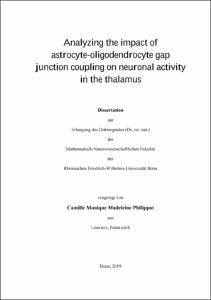Philippot, Camille Monique Madeleine: Analyzing the impact of astrocyte-oligodendrocyte gap junction coupling on neuronal activity in the thalamus. - Bonn, 2020. - Dissertation, Rheinische Friedrich-Wilhelms-Universität Bonn.
Online-Ausgabe in bonndoc: https://nbn-resolving.org/urn:nbn:de:hbz:5-58066
Online-Ausgabe in bonndoc: https://nbn-resolving.org/urn:nbn:de:hbz:5-58066
@phdthesis{handle:20.500.11811/8305,
urn: https://nbn-resolving.org/urn:nbn:de:hbz:5-58066,
author = {{Camille Monique Madeleine Philippot}},
title = {Analyzing the impact of astrocyte-oligodendrocyte gap junction coupling on neuronal activity in the thalamus},
school = {Rheinische Friedrich-Wilhelms-Universität Bonn},
year = 2020,
month = apr,
note = {Glia is now recognized as a key element in brain metabolism. In the thalamus, astrocytes and oligodendrocytes are coupled via gap junction channels and form extensive panglial networks. Interestingly and in contrast to other brain regions, thalamic panglial networks are equally composed of astrocytes and oligodendrocytes. The functional impact of astrocyte-oligodendrocyte coupling in grey matter is still unclear. Thus, thalamic glia properties and their role in brain energy metabolism and neuron-glia signaling were investigated.
The ventral posterior nucleus of the thalamus is part of the somatosensory system and contains elongated cellular domains called barreloids, which are the basic structure for the representation of vibrissae. In the first part of the present study, electrophysiological recordings and immunohistochemistry revealed new features of glial cells in thalamic barreloids. It could be shown that barreloid borders were formed by uncoupled or weakly coupled oligodendrocytes. Furthermore, it could be demonstrated that thalamic panglial networks were dependent on neuronal activity and limited by the barreloid borders.
Oligodendrocytes make up for more than 50% of coupled cells in the thalamus. However, their functional impact remains elusive. The role of thalamic oligodendrocytes in brain energy metabolism was investigated in this study. In acute brain slices, the cortico-thalamic pathway was stimulated and extracellular glucose deprivation (EGD) suppressed thalamic postsynaptic field potentials (fPSPs). This EGD-induced decline could not be rescued by extracellular lactate or pyruvate bath application. However, filling an astrocyte with glucose or lactate was sufficient to rescue the decline of fPSP amplitudes during EGD. Interestingly, loading a single oligodendrocyte with energy metabolites also rescued thalamic fPSP amplitudes during EGD. Next, connexin 32/47 double-deficient mice lacking oligodendroglial coupling were used. Filling an astrocyte with glucose in those mice did not rescue the decline in fPSP amplitudes during EGD. Moreover, employing pharmacological blockers it could be shown that the prevention of the decline of fPSP amplitudes during EGD required glucose and monocarboxylate transporters.
In conclusion, the present study demonstrates that thalamic astrocytes and oligodendrocytes are jointly engaged in maintaining neuronal activity by supplying energy metabolites like glucose and lactate through the panglial network. In addition, these results enhance our understanding of glial network functional dissimilarities between different grey matter and white matter areas.},
url = {https://hdl.handle.net/20.500.11811/8305}
}
urn: https://nbn-resolving.org/urn:nbn:de:hbz:5-58066,
author = {{Camille Monique Madeleine Philippot}},
title = {Analyzing the impact of astrocyte-oligodendrocyte gap junction coupling on neuronal activity in the thalamus},
school = {Rheinische Friedrich-Wilhelms-Universität Bonn},
year = 2020,
month = apr,
note = {Glia is now recognized as a key element in brain metabolism. In the thalamus, astrocytes and oligodendrocytes are coupled via gap junction channels and form extensive panglial networks. Interestingly and in contrast to other brain regions, thalamic panglial networks are equally composed of astrocytes and oligodendrocytes. The functional impact of astrocyte-oligodendrocyte coupling in grey matter is still unclear. Thus, thalamic glia properties and their role in brain energy metabolism and neuron-glia signaling were investigated.
The ventral posterior nucleus of the thalamus is part of the somatosensory system and contains elongated cellular domains called barreloids, which are the basic structure for the representation of vibrissae. In the first part of the present study, electrophysiological recordings and immunohistochemistry revealed new features of glial cells in thalamic barreloids. It could be shown that barreloid borders were formed by uncoupled or weakly coupled oligodendrocytes. Furthermore, it could be demonstrated that thalamic panglial networks were dependent on neuronal activity and limited by the barreloid borders.
Oligodendrocytes make up for more than 50% of coupled cells in the thalamus. However, their functional impact remains elusive. The role of thalamic oligodendrocytes in brain energy metabolism was investigated in this study. In acute brain slices, the cortico-thalamic pathway was stimulated and extracellular glucose deprivation (EGD) suppressed thalamic postsynaptic field potentials (fPSPs). This EGD-induced decline could not be rescued by extracellular lactate or pyruvate bath application. However, filling an astrocyte with glucose or lactate was sufficient to rescue the decline of fPSP amplitudes during EGD. Interestingly, loading a single oligodendrocyte with energy metabolites also rescued thalamic fPSP amplitudes during EGD. Next, connexin 32/47 double-deficient mice lacking oligodendroglial coupling were used. Filling an astrocyte with glucose in those mice did not rescue the decline in fPSP amplitudes during EGD. Moreover, employing pharmacological blockers it could be shown that the prevention of the decline of fPSP amplitudes during EGD required glucose and monocarboxylate transporters.
In conclusion, the present study demonstrates that thalamic astrocytes and oligodendrocytes are jointly engaged in maintaining neuronal activity by supplying energy metabolites like glucose and lactate through the panglial network. In addition, these results enhance our understanding of glial network functional dissimilarities between different grey matter and white matter areas.},
url = {https://hdl.handle.net/20.500.11811/8305}
}






